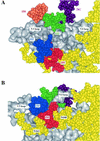The broadly neutralizing anti-human immunodeficiency virus type 1 antibody 2G12 recognizes a cluster of alpha1-->2 mannose residues on the outer face of gp120
- PMID: 12072529
- PMCID: PMC136327
- DOI: 10.1128/jvi.76.14.7306-7321.2002
The broadly neutralizing anti-human immunodeficiency virus type 1 antibody 2G12 recognizes a cluster of alpha1-->2 mannose residues on the outer face of gp120
Abstract
2G12 is a broadly neutralizing human monoclonal antibody against human immunodeficiency virus type-1 (HIV-1) that has previously been shown to bind to a carbohydrate-dependent epitope on gp120. Here, site-directed mutagenesis and carbohydrate analysis were used to define further the 2G12 epitope. Extensive alanine scanning mutagenesis showed that elimination of the N-linked carbohydrate attachment sequences associated with residues N295, N332, N339, N386, and N392 by N-->A substitution produced significant decreases in 2G12 binding affinity to gp120(JR-CSF). Further mutagenesis suggested that the glycans at N339 and N386 were not critical for 2G12 binding to gp120(JR-CSF). Comparison of the sequences of isolates neutralized by 2G12 was also consistent with a lesser role for glycans attached at these positions. The mutagenesis studies provided no convincing evidence for the involvement of gp120 amino acid side chains in 2G12 binding. Antibody binding was inhibited when gp120 was treated with Aspergillus saitoi mannosidase, Jack Bean mannosidase, or endoglycosidase H, indicating that Man(alpha)1-->2Man-linked sugars of oligomannose glycans on gp120 are required for 2G12 binding. Consistent with this finding, the binding of 2G12 to gp120 could be inhibited by monomeric mannose but not by galactose, glucose, or N-acetylglucosamine. The inability of 2G12 to bind to gp120 produced in the presence of the glucose analogue N-butyl-deoxynojirimycin similarly implicated Man(alpha)1-->2Man-linked sugars in 2G12 binding. Competition experiments between 2G12 and the lectin cyanovirin for binding to gp120 showed that 2G12 only interacts with a subset of available Man(alpha)1-->2Man-linked sugars. Consideration of all the data, together with inspection of a molecular model of gp120, suggests that the most likely epitope for 2G12 is formed from mannose residues contributed by the glycans attached to N295 and N332, with the other glycans playing an indirect role in maintaining epitope conformation.
Figures













References
-
- Baba, T. W., V. Liska, R. Hofmann-Lehmann, J. Vlasak, W. Xu, S. Ayehunie, L. A. Cavacini, M. R. Posner, H. Katinger, G. Stiegler, B. J. Bernacky, T. A. Rizvi, R. Schmidt, L. R. Hill, M. E. Keeling, Y. Lu, J. E. Wright, T. C. Chou, and R. M. Ruprecht. 2000. Human neutralizing monoclonal antibodies of the IgG1 subtype protect against mucosal simian-human immunodeficiency virus infection. Nat. Med. 6:200-206. - PubMed
-
- Bewley, C. A. 2001. Solution structure of a cyanovirin-N:Manα1-2Manα complex: structural basis for high-affinity carbohydrate-mediated binding to gp120. Structure 9:931-940. - PubMed
-
- Bewley, C. A., and S. Otero-Quinten. 2001. The potent anti-HIV protein cyanovirin-N contains two novel carbohydrate binding sites that selectively bind to Man8D1D3 and Man9 with nanomolar affinity: implications for binding to HIV envelope glycoprotein gp120. J. Am. Chem. Soc. 123:3892-3902. - PubMed
-
- Boyd, M. R., K. R. Gustafson, J. B. McMahon, R. H. Shoemaker, B. R. O'Keefe, T. Mori, R. J. Gulakowski, L. Wu, M. I. Rivera, C. M. Laurncot, M. J. Currens, J. H. Cardellina, R. W. Buckheit, P. L. Nara, L. K. Pannell, R. C. Sowder, and L. E. Henderson. 1997. Discovery of cyanovirin-N, a novel human immunodeficiency virus-inactivating protein that binds viral surface envelope glycoprotein gp120: potential applications to microbicide development. Antimicrob. Agents Chemother. 41:1521-1530. - PMC - PubMed
Publication types
MeSH terms
Substances
Grants and funding
LinkOut - more resources
Full Text Sources
Other Literature Sources
Medical

